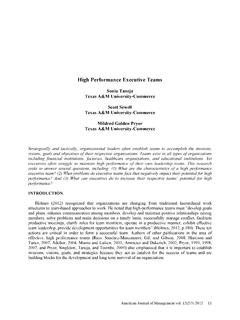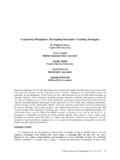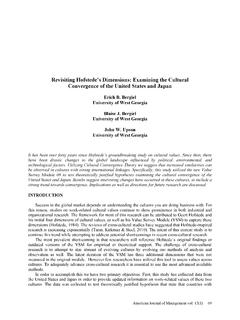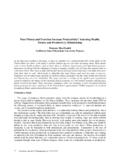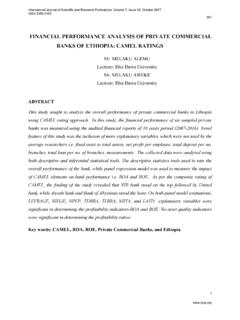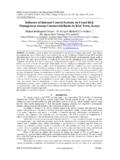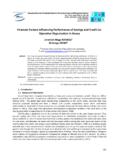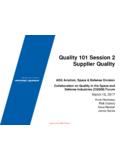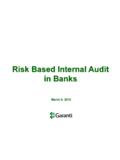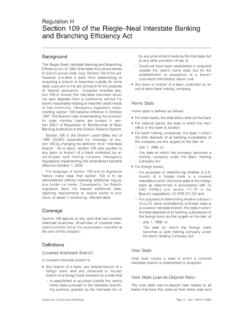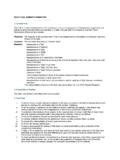Transcription of The Impact of Mission Statement on Performance: …
1 The Impact of Mission Statement on performance : an exploratory Study in the Jordanian Banking Industry Ammar Ali Alawneh Yarmouk University, Jordan This study aims at assessing Mission statements in the Jordanian banking industry. More specifically, it explores Mission statements in terms of components and their Impact on performance . The content analysis of Mission statements for 13 banks was carried out to meet the research objectives. Both descriptive and inferential analysis techniques were utilized. The results indicate that banks are very interested to possess Mission statements.
2 However, regarding to the content, it seems that no equal attention has been given to the components of Mission statements. The results also provide no support to the correlation between Mission statements' components and performance . INTRODUCTION Several studies have reported the increasingly role of strategic management and its Impact on organizational performance (Whleen & Hunger, 2012). Mission Statement is considered as an essential part of strategic management process (Cochran, et al., 2008; Morphew & Hartley, 2006). It primarily serves as a managerial tool that forms the basis for the strategic management phases: formulation, implementation, and evaluation (Bart, et al.)
3 , 2000; Bryson, 1995; Ireland & Hitt, 1992; Pearce & Roth, 1988; Stone, 1996). Earlier studies have clearly addressed the importance of Mission Statement . Moreover, its strategic role is well-documented and supported in the associated literature of business management studies in general and strategic management studies in particular (Ireland & Hitt, 1992; Staples & Black, 1984; Sufi & Lyons, 2003). Given that a Mission Statement is perceived as the starting point for shaping and directing the entire organization, it has obtained a great attention by both academic and practitioners.
4 Actually, studies of Mission Statement were found in the early of 1970s (Sufi & Lyons, 2003). Empirically, Iseri Say et al. (2008) found that more than 84% of managers believe that the Mission Statement among the most important managerial tool. Another empirical study revealed that Mission statements and values were ranked among the top managerial tools since it plays an integral role in firms by helping organizational members to emphasize on objectives and to work together on the same direction (Rigby, 1994). With respect to the role of Mission Statement , Pearce and David (1987) stated that there are three major roles: to establish the foundation for strategies, plans, and work activities priorities; to set the basis for the organizational design and structure; and to justify why an organization exists.
5 Additionally, it helps a firm to distinguish itself from rivals in terms of corporate identity (Leuthesser & Kohli, 1997), legitimacy and direction (Want, 1986). There are three main reasons for organizations to have Mission statements; it is a cornerstone in the strategic planning (Pearce, 1982; Pearce & David, 1987; Staples & Black, 1984; Stone, 1996), as a tool of Journal of Management Policy and Practice Vol. 16(4) 2015 73communication to public, as well as an internal communication tool by steering the decisions making process, directing and coordinating organizational activities, and managers behaviors (Bart & Tabone, 1999; Campbell & Nash, 1992; Collins-Jarvis, 1997).
6 In other words, Mission Statement works mainly as a communication tool and expresses future objectives (Bartkus et al., 2000). Several benefits of Mission Statement have been reported in the related literature including communicating a sense of the firm's direction and purpose, serving as a control mechanism to keep a firm on track, making a wide range of day-to-day decisions and to inspire and motivate employees (Bartkus et al., 2000). There are several imperative features and characteristics of Mission Statement . For instance, Mission statements vary in their length, number of words, general or specific (Bart & Hupfer, 2004).
7 Several studies (David and David, 2003; Davies and Glaister, 1997; Kemp and Dwyer, 2003) suggest that Mission contains almost 100 words in length. Moreover, Mission Statement must be free of financial expression, numbers, percentages, ratios or objectives (cited in David et al., 2014). Fred (2003) recommends 200 words as an ideal length of Mission statements. The Mission Statement contents must be reflected in actions behavior (Bartkus and Glassmn, 2007). An effective Mission Statement is also an important issue that should be given a great deal of consideration. In this issue, Ackoff (1986) claims that an effective Mission Statement should be challengeable, contains measurable goals, differentiate the firm from its competitors, inspirational and pertinent to all stakeholders.
8 King et al., (2010) contend that a well designed and a comprehensible Mission Statement plays a critical role on setting objectives effectively and on quality of plans' formulation. Lynch (2000) maintains that an effective Mission Statement should be specific, flexible, distinctive, attainable and realistic. Sattari et al., (2011) assert that a comprehensive, readable, concise, clear Mission Statement is very essential to obtain the expected benefits and the desired outcomes. Vandijck et al., (2007) point out that a well designed Mission Statement works as an energy source, guide decision making and employees' behaviors.
9 In the current business environment there is a rapidly growing literature on Mission Statement and more considerable to Mission Statement has been given not only by profit but also by non-profit organizations (Cochran et al., 2008; Krik et al., 2010; Gilson, 2012). These include educational organizations (James & Huisman, 2009; Palmer & Short, 2008), religious organizations (Zandstra, 2012), healthcare organizations (Forenhand, 2000; Vandijcke et al., 2007). Furthermore, the attention extends to small-and medium-sized organizations (Analoui & Karami et al., 2002). RESEARCH PROBLEM There is a wide assumption of a strong linkage between Mission Statement and organizational performance .
10 A review of the related literature have revealed that the research of Mission Statement and performance can be divided mainly into three aspects: the Impact of existence and nonexistence of Mission Statement on performance , the content of Mission Statement , and the Impact of Mission Statement components' on performance (Dermol, 2012). Generally speaking, studies show consistent results in terms of main components. In relation to the Impact of Mission Statement on performance studies still show mixed results. While some of them show positive relationships, the others show negative relationships (O'Gorman & Doran, 1999).
